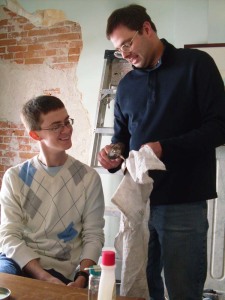 Last week, we received the final eleven Campbell goblets that a local family donated to us after purchasing them in the 1941 Selkirk auction. [Here’s the scoop in case you missed the original post.]
Last week, we received the final eleven Campbell goblets that a local family donated to us after purchasing them in the 1941 Selkirk auction. [Here’s the scoop in case you missed the original post.]
Today, it’s time to check these goblets in. In museum vernacular, the formal process of bringing an item (or in this case, items) into the collection is called accessioning.
We taught intern Sam how to accession today, and we thought you would get a kick out of a behind-the-scenes peek at what we do.
-

Sam getting his silver-polishing lesson from Andy. Step 1: Clean the item. In this case, the sterling goblets were pretty tarnished after years of being in storage, so Executive Director Andy gave Sam a lesson on how to polish silver like a champ.
- Step 2: Assign an accession number. “Accession number” is just a museum-y way of saying “inventory number.” Every item in our collection has a unique accession number, and they have a three-number format, e.g.: 2012.1.1. The first part is the year in which the donation was received, the second part is the donation number (in the example above, this is the first donation we logged in 2012), and the third is the item number within that donation. The first goblet will be 2012.1.1, while the last (12th) goblet will bear the number 2012.1.12. Say next week your great aunt Edna donates a desk that used to belong to the Campbells. That accession number would be 2012.2.1. If Edna threw in the matching chair? 2012.2.2. And inkwell? 2012.2.3. You get the picture.
-

Tools of the trade: B72, a specially-cropped cotton swab, and special acid-free archival pen. Step 3: Label the item with the accession number. Somehow. You’ve probably never thought about how you would label a piece of sterling. On the off chance you did, you probably weren’t concerned with doing it in such a way that you could remove the label if necessary. If we used a Sharpie on the bottom of the goblet, that ink would be on there for good. We don’t want to do that because a Sharpie would alter the condition of the object. We want it to be good as new. (Or at least as good as it was when we received it.) First rule in the museum world: Do no harm. So how do you write on a silver goblet without really writing on it? In this case, something called B72. It’s a clear gel-like substance that, after painting it on a solid object like glass, porcelain or silver, you can write on it. [Editorial comment: In addition to being an indispensable museum tool, it stinks to high heaven.] If you don’t want the number on the object any more, simply hit the section with a little bit of acetone and it will remove the writing and the patch of B72.

Andy supervising as Sam tries his hand at applying B72 on the bottom of a goblet. - Step 4: Enter the new object into the inventory software. We have a lot of stuff to keep track of in this house, but it’s a small inventory in the greater museum world. In terms of number of items, our collection is downright modest when you compare it to the St. Louis Art Museum or the Missouri History Museum. Therefore, we use a small software system called PastPerfect. It combines museum inventory software and our donor/membership database, and it works just swell for us. (Incidentally, PastPerfect hosts our online collection database so you can look up letters and objects in our collection.) In here, Sam’s going to enter all the particulars: description, provenance, donor, condition, images and the location in the house so we know where to find it.
Next comes the really fun part: deciding where to feature the goblets in the house.
And that is how we accession new items into Campbell House’s collection.
